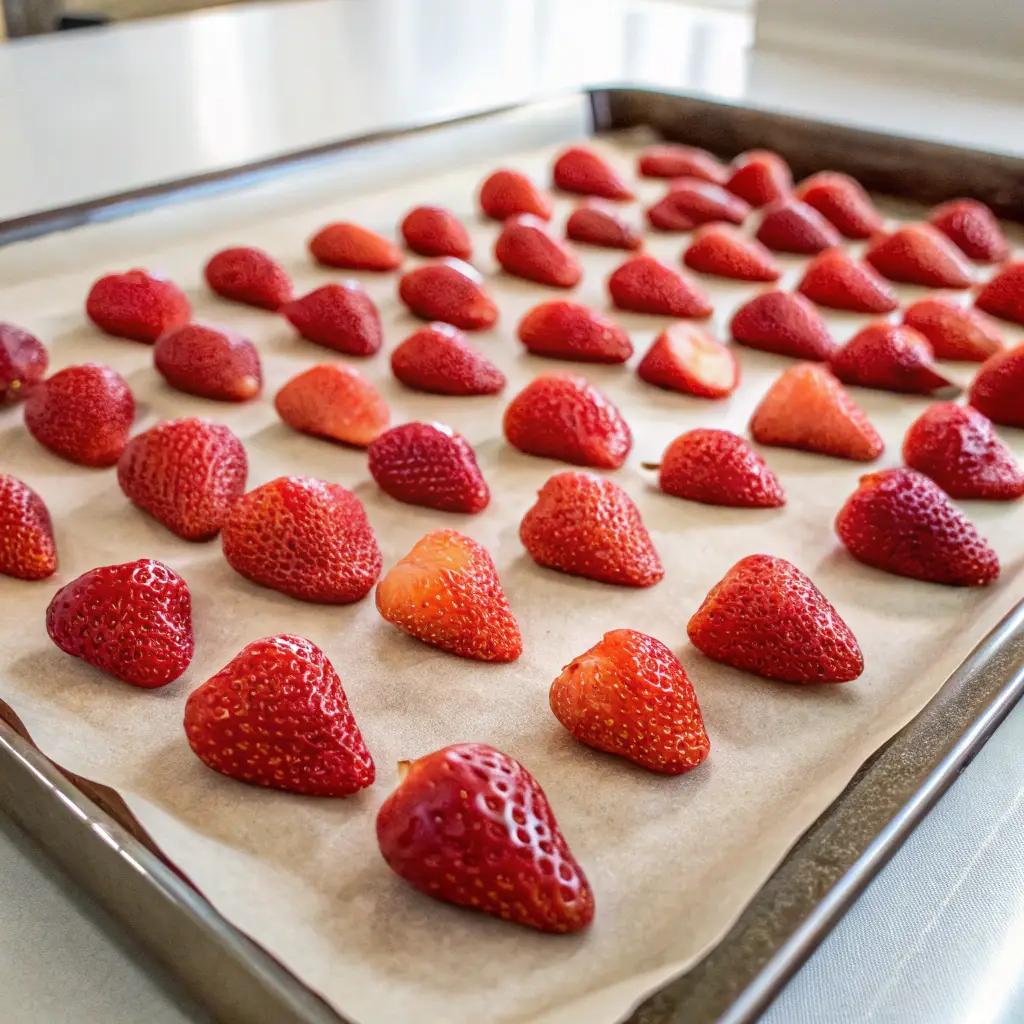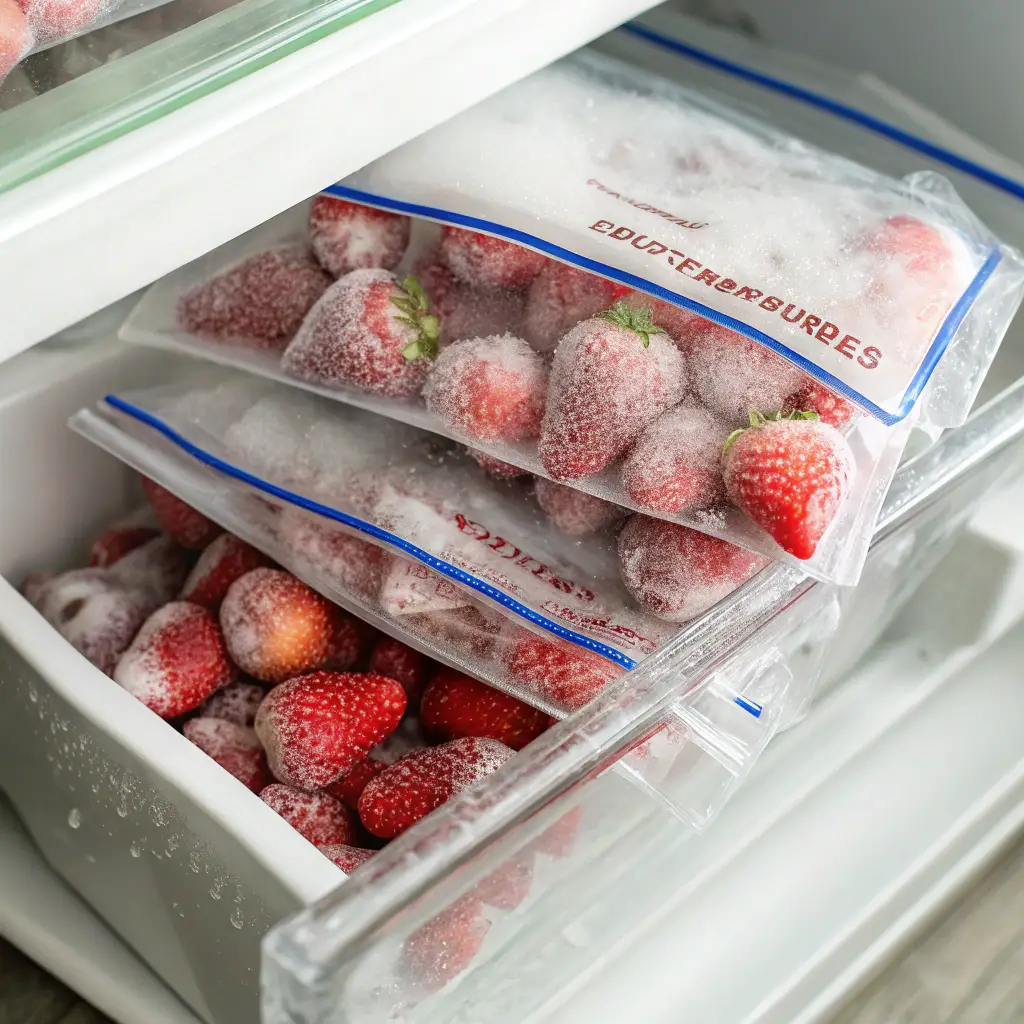Freezing strawberries is one of the easiest ways to preserve their sweet flavor and juicy texture for months—no waste, no rush to eat, and all the flavor locked in. Whether you’ve picked up a fresh haul from the farmer’s market or grown your own backyard batch, knowing how to freeze strawberries properly means you’ll always have a stash ready for smoothies, baking, desserts, or snacking.
In this article, we’ll explore everything you need to know about freezing strawberries—from the best methods to long-term storage tips. You’ll learn how to prepare strawberries for freezing, whether Ziploc bags or airtight containers work better, and which method keeps them from clumping into one icy mess. We’ll even show you how to thaw frozen strawberries without them getting soggy, so they’re as close to fresh as possible.
Plus, we’ll answer frequently asked questions like “Can I freeze strawberries in Ziploc bags?” and “What’s the best way to store frozen strawberries for baking?”
Don’t miss our easy guide on freezing rotisserie chicken—perfect if you’re meal prepping more than fruit!
Let’s dive in and make your strawberries last all year long.
Table of Contents
PART 1: Why Freeze Strawberries?
Preserving Freshness and Nutrients
Freezing strawberries is one of the most effective ways to enjoy their sweet, juicy goodness long after strawberry season ends. When done correctly, frozen strawberries retain most of their vitamins, antioxidants, and fiber content. Unlike canned or overly processed options, frozen strawberries keep their natural flavor and texture, especially when frozen at peak ripeness. This means you can enjoy garden-fresh taste in smoothies, jams, or baked goods any time of year.
Saving Money and Reducing Waste
Have you ever bought a large batch of strawberries only to watch them spoil in the fridge within days? Freezing eliminates that worry. Whether you’re a gardener, bulk buyer, or simply snagged a great deal at the market, freezing strawberries helps reduce food waste and saves money. Instead of tossing overripe berries, pop them in the freezer to extend their shelf life by up to 8–12 months.
Plus, it’s super cost-effective. Frozen strawberries from the store can be pricey, especially if organic. Freezing your own gives you full control over quality and cleanliness—no added sugar or preservatives.
Easy and Convenient for Recipes
Frozen strawberries are incredibly versatile. You can throw them straight into smoothies, make sauces, or thaw them for pies and pancakes. Having a batch on hand saves prep time and makes it easy to whip up a quick breakfast or dessert.
Looking for inspiration? Try our frozen salmon in air fryer guide—another freezer-friendly favorite!
Freezing strawberries isn’t just about storage—it’s about convenience, savings, and flavor all in one go. Now that you know why it’s worth it, let’s move on to how to prep strawberries for the freezer.
PART 2: How to Prepare Strawberries Before Freezing

Wash and Sort the Strawberries
Before freezing, it’s crucial to start with the best-quality berries. Choose ripe, firm strawberries with no soft spots or mold. Wash them thoroughly under cool running water. Gently rub off any dirt but avoid soaking them, as strawberries absorb water easily, which can lead to freezer burn.
After washing, pat them completely dry with a paper towel or clean cloth. Extra moisture on the surface can cause ice crystals and clumping later in the freezer.
Remove the Stems and Slice (Optional)
Once dry, remove the green tops and hull the strawberries using a paring knife or a strawberry huller. You can freeze them whole, halved, or sliced, depending on how you plan to use them later. Sliced berries are great for smoothies and baking, while whole berries are perfect for decorating or dipping.
Pro tip: Smaller pieces freeze faster and thaw more evenly, but whole strawberries maintain their shape better.
Pre-Freeze for Best Texture
This step makes all the difference. Spread your strawberries in a single layer on a baking sheet lined with parchment paper, making sure they don’t touch. Place the tray in the freezer for 2–4 hours, or until each berry is frozen solid. This prevents them from sticking together and keeps their shape intact.
Once frozen, transfer them to a freezer-safe container.
Discover great ideas like our crock pot beef tips and gravy—another delicious freezer-friendly option.
Now that your strawberries are prepped and frozen the right way, let’s talk about storage methods. What kind of containers work best? And can you use Ziploc bags?
PART 3: Best Containers and Storage Tips for Freezing Strawberries

Choosing the Right Storage: Ziploc Bags vs. Containers
When it comes to freezing strawberries, your choice of storage container matters. Ziploc freezer bags are one of the most popular options. They’re affordable, space-saving, and easy to label. You can remove extra air before sealing, which helps prevent freezer burn and keeps the strawberries fresh for longer.
Another great option is airtight containers—especially those made from BPA-free plastic or freezer-safe glass. While they take up more space, they’re reusable, sturdy, and ideal if you want to avoid crushing delicate berries during freezer storage.
If you’re freezing large batches, consider vacuum sealing for maximum freshness. It’s an investment, but it extends freezer life significantly and keeps your strawberries tasting as close to fresh as possible.
Label and Date Everything
Always label your containers or bags with the freezing date and quantity. This helps with meal prep and ensures you use older batches first. Frozen strawberries are best used within 8–12 months for peak flavor and texture.
Organize Your Freezer Like a Pro
Don’t just toss your strawberries in the back of the freezer. Lay the bags flat to save space and keep things organized. Stack them once frozen to create a neat, easy-to-access stash. This helps prevent the berries from getting buried or forgotten.
Check out this easy crock pot chicken enchiladas recipe—perfect with a strawberry salsa twist!
With the right containers and storage tricks, your strawberries will stay fresh and ready to use. Up next, we’ll cover freezing techniques. Which method is best for your needs?
PART 4: Freezing Techniques: Which Method Is Best for You?
Method 1: Dry Freezing (Best for Baking and Smoothies)
The dry freezing method is the simplest and most widely used. After washing, hulling, and drying your strawberries, lay them on a baking sheet lined with parchment paper and freeze them individually. Once solid, transfer them into Ziploc bags or containers.
This method keeps berries from sticking together, making it easier to grab just the amount you need for smoothies, muffins, or sauces.
Ideal for: Smoothies, baking, and quick recipes
Pros: No clumping, retains shape, easy portioning
Cons: Requires space and an extra freezing step
Method 2: Sugar Pack Freezing (Best for Desserts)
Want to keep strawberries sweet and soft? Toss halved or sliced strawberries in a little sugar—about ½ cup per quart of fruit—then let them sit until juices form. Spoon the mixture into freezer-safe containers, leaving a bit of headspace.
Ideal for: Ice cream toppings, pies, shortcake
Pros: Enhances flavor, softer texture
Cons: Adds sugar, not suitable for low-sugar diets
Method 3: Syrup Pack Freezing (For Long-Term Storage)
Combine 1 cup of sugar with 4 cups of water to make a light syrup. Pour over strawberries in containers. This method helps retain color and shape over long periods.
Ideal for: Preserving texture for special desserts
Pros: Excellent appearance, extended shelf life
Cons: Takes more time, adds liquid
Don’t miss our guide on storing scrambled eggs—another smart food-saving trick!
Now that you know how to freeze strawberries, let’s learn how to thaw them the right way—without making them mushy.
Want more detailed guidelines on food freezing safety? The FDA’s Freezing and Food Safety Guide (dofollow PDF) outlines essential storage temperatures and safety tips to follow when freezing produce at home.
PART 5: How to Thaw Frozen Strawberries Without Making Them Soggy
Why Thawing the Right Way Matters
After learning how to freeze strawberries correctly, the next step is knowing how to thaw them without turning them into a soggy mess. Strawberries have high water content, and improper thawing can ruin their texture. Whether you’re baking, blending, or topping a dessert, getting the consistency right starts with a gentle thaw.
Method 1: Thaw in the Refrigerator (Best Overall)
For best results, place frozen strawberries in a bowl and let them thaw overnight in the fridge. This slow, steady method preserves both flavor and structure. It’s ideal if you’re using them as toppings or in recipes where presentation matters, like strawberry shortcake or tarts.
Pro Tip: Place a paper towel under the berries to absorb excess moisture.
Method 2: Thaw at Room Temperature (Quick Use)
In a rush? Let your strawberries sit on the counter for 1–2 hours. While faster, this can lead to slightly mushier results. Use this method when you’re blending into smoothies or cooking down into syrup.
Method 3: Use Frozen (No Thaw Needed)
Many recipes, especially smoothies, sauces, or oatmeal, don’t require thawing at all. Using strawberries straight from the freezer saves time and even helps chill your dish naturally.
Check out our mini chocolate chip muffins recipe—frozen strawberries pair perfectly in the batter!
No matter your method, the key is to avoid microwaving, which causes uneven thawing and excess moisture. Next, let’s answer some of the most common questions about freezing strawberries.
PART 6: Delicious Ways to Use Frozen Strawberries
Strawberry Smoothies and Breakfast Bowls
Frozen strawberries blend perfectly into smoothies, giving a thick, creamy texture without needing ice. Combine them with bananas, Greek yogurt, and almond milk for a nutrient-packed breakfast. You can also thaw them slightly and top oatmeal, granola, or acai bowls with a burst of berry flavor.
Strawberry Sauces and Jams
Turn your frozen berries into homemade strawberry sauce or quick freezer jam. Just cook them down with a bit of sugar and lemon juice until thick. These are great on pancakes, waffles, and ice cream.
Frozen Strawberry Desserts
Try using them in baked goods like muffins, cakes, or cobblers. Frozen berries work well in recipes that require cooking, as the extra moisture won’t impact the outcome much.
FAQS
What’s the Best Way to Freeze Fresh Strawberries?
The best way to freeze fresh strawberries is to wash, hull, and completely dry them, then pre-freeze them in a single layer on a parchment-lined baking sheet. Once solid, transfer them to an airtight container or Ziploc freezer bag. This keeps the berries from sticking together and preserves their shape, flavor, and texture.
Can I Freeze Strawberries in Ziploc Bags?
Yes, you can freeze strawberries in Ziploc freezer bags, and it’s actually one of the most convenient and space-saving methods. Make sure to remove as much air as possible from the bag before sealing to prevent freezer burn. Label the bag with the date and store it flat for easy stacking in your freezer.
Which Freezing Method Is Most Suitable for Strawberries?
It depends on your use case.
For smoothies or baking: Dry freezing is best.
For desserts or toppings: Try the sugar pack method.
For long-term storage: Use the syrup pack method.
Each technique preserves strawberries differently based on texture and sweetness needs.
How to Thaw Frozen Strawberries Without Making Them Soggy?
To avoid soggy strawberries, thaw them slowly in the fridge overnight. This reduces moisture loss and preserves firmness. If using them in smoothies, skip thawing entirely and add them straight from the freezer.
Don’t miss our guide on crab brulee—another unique way to get creative in the kitchen.
By understanding these basics, you can freeze and use strawberries more effectively year-round. Up next, let’s explore how to use frozen strawberries in everyday recipes.
Conclusion
Freezing strawberries the right way is a total game changer. Whether you’re stocking up during berry season or saving extras from going bad, knowing how to freeze strawberries gives you a year-round supply of sweet, juicy flavor. The key is choosing the right method for your needs—dry freezing, sugar pack, or syrup—and storing them properly in airtight containers or Ziploc freezer bags.
With smart thawing and storage, your frozen strawberries will be perfect for smoothies, baked treats, sauces, and more. Ready to preserve that sweetness? Follow this guide and enjoy strawberries anytime, anywhere.
Learn more about vegetables for toddlers—another fresh and freezer-friendly idea!

